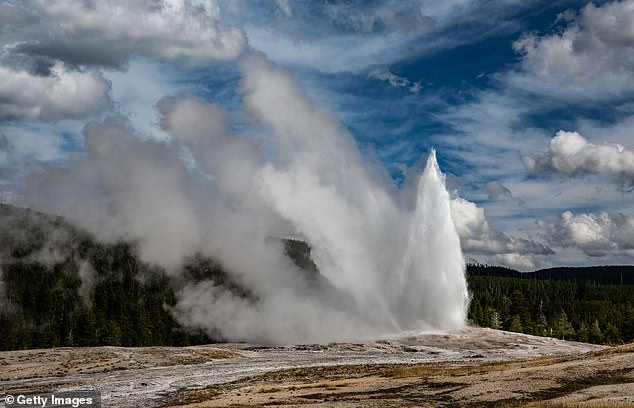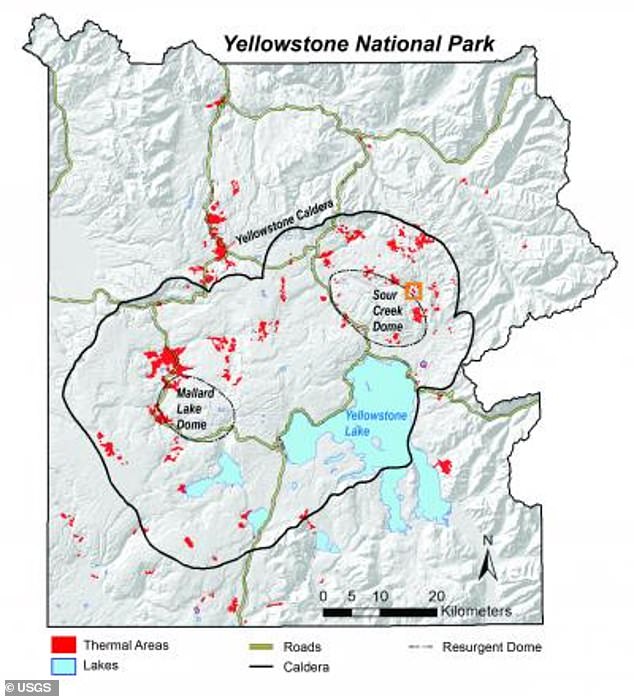Scientists investigating the Yellowstone supervolcano have discovered movement deep in the crater, sparking fears the sleeping giant could erupt.
The volcano, located under Yellowstone National Park in Wyoming, is capable of producing a devastating magnitude 8 eruption.
And because it has not exploded in about 640,000 years, some experts and locals believe the volcano is overdue.
Researchers analyzing the supervolcano’s crater, or caldera, found magma inside is moving northeast and shifting the concentration of volcanic activity along with it.
That means if the volcano were to erupt, it would happen in this area compared to previous warnings in the western region.
The Yellowstone Caldera is the 1,350-square-mile crater in the western-central portion of the park that formed when this volcano cataclysmically erupted hundreds of thousands of years ago.
The team found that the bulk of this magma is stored in segregated underground reservoirs, which prevents it from becoming concentrated enough to cause an eruption.
While an eruption could happen in the northeastern region due to the shift, researchers said their findings suggest that the supervolcano will not erupt within our lifetime.


‘Nowhere in Yellowstone do we have regions that are capable of eruption,’ lead author Ninfa Bennington, a research geophysicist at the Hawaiian Volcano Observatory, told the Washington Post.
‘It has a lot of magma, but the magma is not connected enough.’
Bennington and her colleagues performed a wide-scale magnetotelluric survey across the Yellowstone Caldera.
The technique works by listening to the Earth’s natural “signals,” like radio waves and magnetic vibes that come from space or deep in our planet.
These signals change depending on what kind of stuff—like rocks, water, or metals—is underground.
This allowed the researchers to peer into the crater and investigation what was really happening below the surface.
They used the resulting data to map the magma formations beneath the Caldera.
The results indicated that there are at least seven main regions of high magma content at depths between 2.5 and 30 miles below the surface, revealing that these reservoirs are ‘not eruptible.’
The researchers published their findings in the journal Nature on Wednesday.
Previous research has shown that there are two types of magma below the Yellowstone Caldera.
One is basaltic magma, which is commonly produced by direct melting of the Earth’s mantle, according to the US Geological Survey (USGS).


Basaltic magma erupts more readily due to its lower resistance to flow. But this magma is dense and buried deep beneath the Yellowstone Caldera, which means it is unlikely to cause an eruption there.
The other type is rhyolitic magma, which is thicker and more resistant to flow because of its high silica content.
Underneath Yellowstone, deep-seated basaltic magma heats the surrounding rock, which helps create rhyolitic magma closer to the surface.
But it would take a large build-up of pressure for rhyolitic magma to erupt from Yellowstone.
It has happened before, however. The the past two million years, Yellowstone has produced three large, caldera-forming eruptions, all driven by reservoirs of rhyolitic magma.
But this is unlikely to happen again, at least with our lifetimes, according to the researchers.
Based on the volume of rhyolitic magma storage beneath the northeast Yellowstone Caldera, and the region’s direct connection to a heat source in the lower crust, the researchers concluded that the concentration of future rhyolitic volcanic activity has shifted northeast.
This is a significant change. For the last 160,000 years, rhyolitic volcanic activity has occurred across the majority of the Yellowstone Caldera with the exclusion of this northeast region, the researchers wrote in their report.
Due to the large volume of magma beneath the National Park, this region will remain volcanically active, according to Bennington.
But her research suggests tourists will not have to worry about the threat of a large eruption anytime soon.

